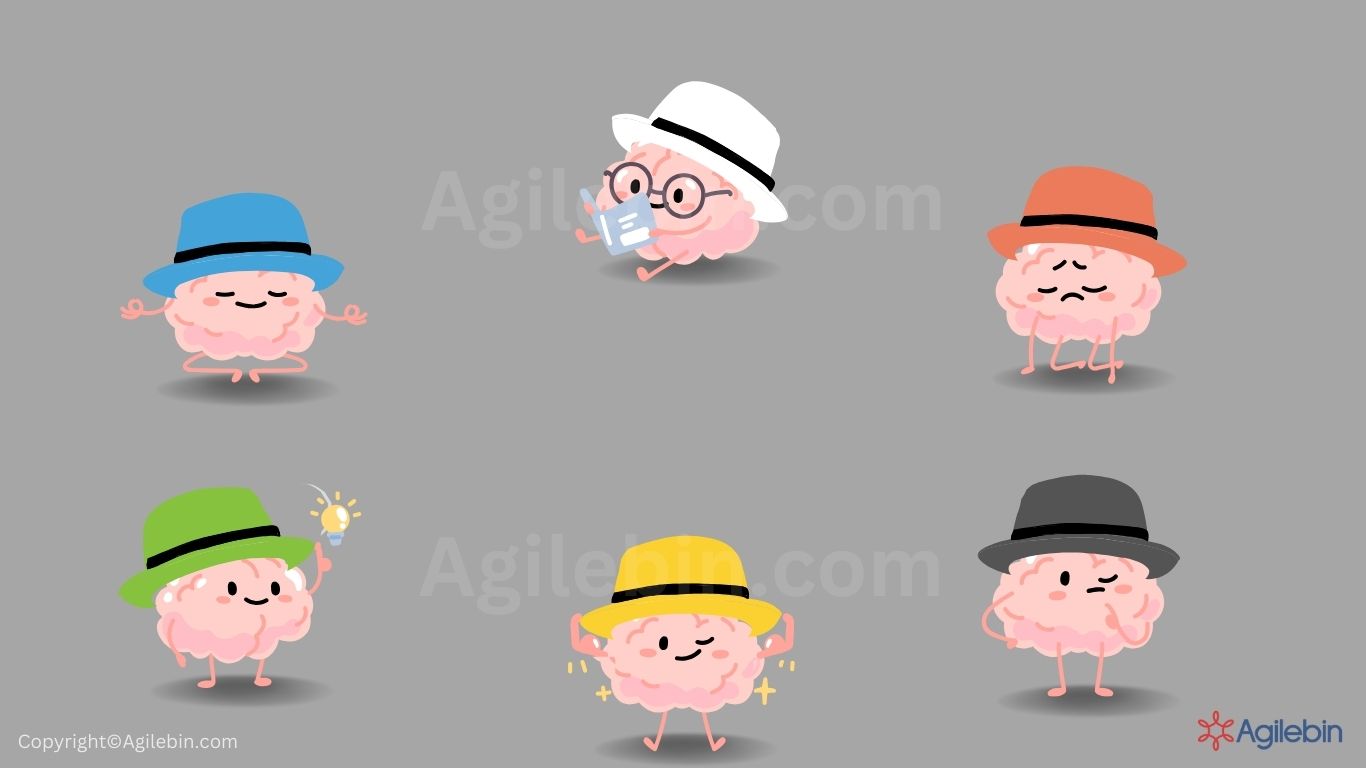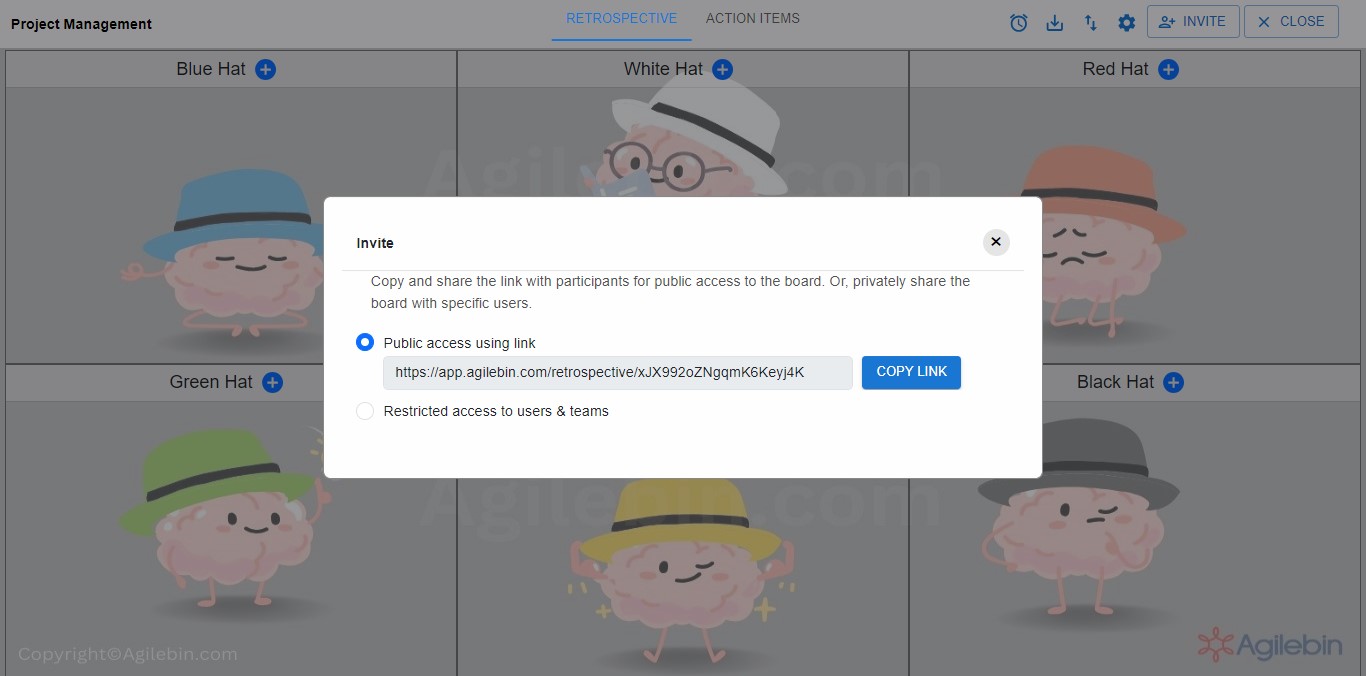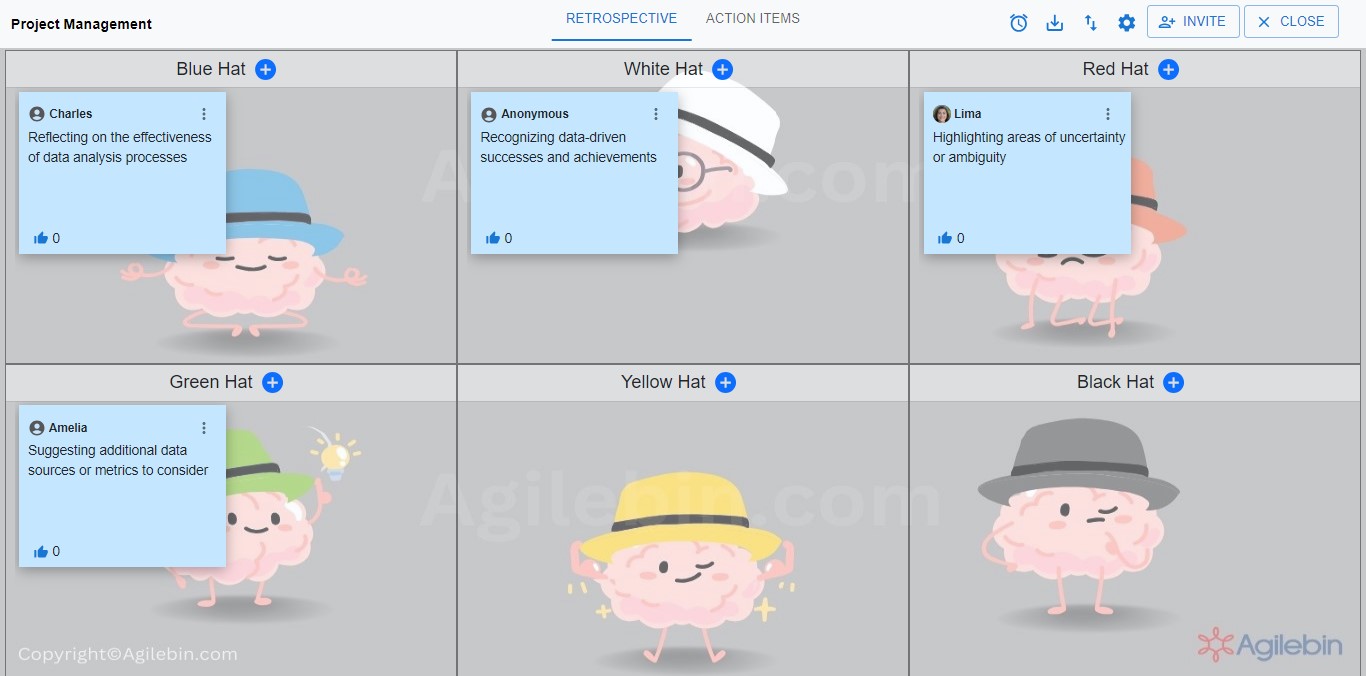Six Thinking Hats Retrospective
Team employs varied viewpoints to enhance problem-solving and decision-making

What is Six Thinking Hats Retrospective?
The Six Thinking Hats retrospective is a structured approach to team reflection and problem-solving, fostering creativity, critical thinking, and collaboration. Inspired by Edward de Bono's method, this technique encourages participants to adopt different perspectives during discussions, facilitating a comprehensive examination of the topic under review. Each perspective offers a unique angle for analysis, ensuring inclusive participation and consideration of diverse viewpoints. Through this structured approach, teams can uncover valuable insights, generate innovative solutions, and make well-informed decisions, ultimately driving continuous improvement within the team.
How to Run Six Thinking Hats Retrospective?
To run a Six Thinking Hats Retrospective, follow these steps
- Encourage Balanced Participation: Ensure that all team members have an opportunity to contribute to the discussion by actively encouraging quieter members to share their thoughts and opinions. This helps to foster inclusivity and ensures that a diverse range of perspectives is considered.
- Manage Time Effectively: Allocate a specific amount of time for each hat perspective to keep the discussion on track and prevent any single perspective from dominating the conversation. Use timekeeping techniques such as setting timers or using visual cues to signal when it's time to transition to the next hat.
- Promote Constructive Feedback: Emphasize the importance of providing constructive feedback during the retrospective, focusing on specific observations and actionable suggestions rather than personal criticism. This creates a supportive environment where team members feel comfortable sharing their insights and ideas.
- Explore Root Causes: Encourage deeper exploration of underlying issues or root causes that may be contributing to challenges or opportunities identified during the retrospective. Use probing questions to uncover the underlying factors driving certain behaviors or outcomes.
- Celebrate Successes: Take time to celebrate successes and achievements identified during the retrospective, recognizing the hard work and contributions of team members. This boosts morale and reinforces positive behaviors that contribute to the team's success.
- Embrace Iteration: Recognize that the Six Thinking Hats retrospective is an iterative process and that continuous improvement takes time. Encourage the team to revisit the same topic in future retrospectives to track progress and assess the impact of implemented changes.
- Facilitate Open Dialogue: Foster an environment of open dialogue and mutual respect where team members feel comfortable expressing their thoughts and opinions without fear of judgment. Encourage active listening and empathy to ensure that all perspectives are valued and considered.
Columns in Six Thinking Hats Retrospective
Typically, the retrospective is divided into six columns:
- White Hat (Facts): Team members present objective information, data, and evidence relevant to the retrospective topic. This could include metrics, performance indicators, customer feedback, or any other factual observations that provide a clear understanding of the current situation.
- Red Hat (Emotions): Participants express their feelings, intuitions, and emotional responses to the topic. This allows for the acknowledgment of subjective experiences and personal reactions, providing valuable insights into the team's emotional dynamics and motivations.
- Black Hat (Cautions): The team takes on a critical perspective, identifying potential risks, challenges, and concerns associated with the retrospective topic. This critical analysis helps the team anticipate obstacles and develop strategies to mitigate them, ensuring a more robust and resilient approach moving forward.
- Yellow Hat (Positives): Team members highlight opportunities, strengths, and positive aspects associated with the topic. By focusing on what is working well, the team can leverage its strengths and build on past successes, fostering confidence and motivation among team members.
- Green Hat (Creativity): Participants engage in brainstorming, idea generation, and exploration of alternative approaches to the topic. This creative phase encourages out-of-the-box thinking and fosters innovative solutions, helping the team break free from conventional thinking patterns and explore new possibilities.
- Blue Hat (Process): The facilitator or organizer of the retrospective guides the discussion, ensuring that all perspectives are considered and that the conversation remains focused and productive. The Blue Hat sets the agenda, manages time, and navigates the team through each "hat" phase, ensuring that the retrospective achieves its objectives.
When to do a Six Thinking Hats Retrospective
A Six Thinking Hats retrospective can be conducted at various points in a project lifecycle or at specific intervals, depending on the team's needs and objectives. Here are some common scenarios for conducting a Six Thinking Hats retrospective:
- End of a Sprint or Iteration: Teams often conduct retrospectives at the end of each sprint or iteration in agile methodologies like Scrum. This allows the team to reflect on their performance during the sprint, identify successes, challenges, and opportunities for improvement, and make adjustments before starting the next sprint.
- Project Milestones: Six Thinking Hats retrospectives can also be conducted at significant milestones or checkpoints within a project. This could be after completing a major phase of development, reaching a key deliverable, or at the end of a project iteration. It provides an opportunity for the team to reflect on progress, assess outcomes, and adjust strategies as needed.
- After Significant Events or Changes: Retrospectives can be valuable after significant events or changes within the team or project, such as the introduction of new team members, changes in project scope, or the adoption of new tools or processes. It provides an opportunity to assess the impact of these changes and make any necessary adjustments.
- Quarterly or Periodic Reviews: Some teams prefer to conduct Six Thinking Hats retrospectives on a regular basis, such as quarterly or bi-monthly. This allows for a more comprehensive review of performance over a longer period, enabling the team to identify trends, patterns, and recurring issues that may require attention.
- As Needed: Additionally, Six Thinking Hats retrospectives can be conducted ad-hoc whenever the team feels it's necessary to reflect on their performance, address specific issues, or capitalize on emerging opportunities. This flexible approach allows teams to adapt to changing circumstances and maintain a focus on continuous improvement.
How can you conduct a Six Thinking Hats retrospective with Agilebin?
Effortlessly conduct a Six Thinking Hats retrospective with Agilebin's ready-to-use template!
Why Agilebin's template? Because it provides a realistic and immersive experience, making your Six Thinking Hats retrospective feel authentic and meaningful. With Agilebin's ready-to-use template, you'll feel like you're navigating through the actual process, allowing for a more effective and insightful retrospective session.
Choose Six Thinking Hats retrospective template in Agilebin
Choose the Six Thinking Hats Retrospective template from Agilebin's collection of retrospective templates. This template is specifically designed to facilitate the Six Thinking Hats Retrospective process, providing a structured framework for your team's reflection and improvement discussions
Invite team members to participate in the retrospective session
Invite team members to participate in the retrospective session by adding their email addresses or sharing the session link directly with them. You can choose between public access using a link, allowing anyone with the link to join, or restricted access, limiting participation to specific users or teams.

Facilitate Discussion with Sticky Notes
Agilebin offers pre-defined columns for the Six Thinking Hats Retrospective, including 'White Hat (Facts)', 'Red Hat (Emotions)', 'Black Hat (Cautions)', 'Yellow Hat (Positives)', 'Green Hat (Creativity)', 'Blue Hat (Process)'. Participants can add sticky notes to each column during the retrospective session, sharing their feedback, observations, and suggestions
